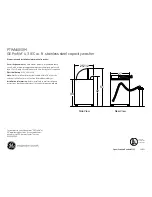
Problem solving guide
75
Problem
Cause and remedy
Crockery is not dry or
cutlery and glasses are
flecked.
The rinse aid dosage is set too low or the rinse aid
reservoir is empty.
Replenish the reservoir, increase the dosage or
change the brand of rinse aid (see "Before using
for the first time, Rinse aid").
Crockery was taken out of the cabinet too soon.
Leave it in for longer (see "Operation").
Combination products have been used which have
impaired drying performance.
Change your detergent, or replenish the rinse aid
(see "Before using for the first time, Rinse aid").
Glassware has a brown
or blue tinge, and film
cannot be wiped off.
This may be caused by the detergent.
Change your detergent.
Glassware is dull and
discoloured; film cannot
be wiped off.
The glassware is not dishwasher-proof. The surfaces
are affected.
There is no remedy.
Purchase glassware which is dishwasher-proof.
Tea or lipstick stains
have not been com‐
pletely removed.
The wash temperature of the selected programme
was too low.
Select a programme with a higher wash tempera‐
ture.
The bleaching effect of the detergent used is too low.
Change your detergent.
Plastic items are discol‐
oured.
Natural dyes e.g. from carrots, tomatoes or ketchup
may be the cause. The amount of detergent used or
its bleaching effect was not sufficient to deal with
natural dyes.
Use more detergent (see "Operation, Detergent").
Discolouration is irreversible.














































